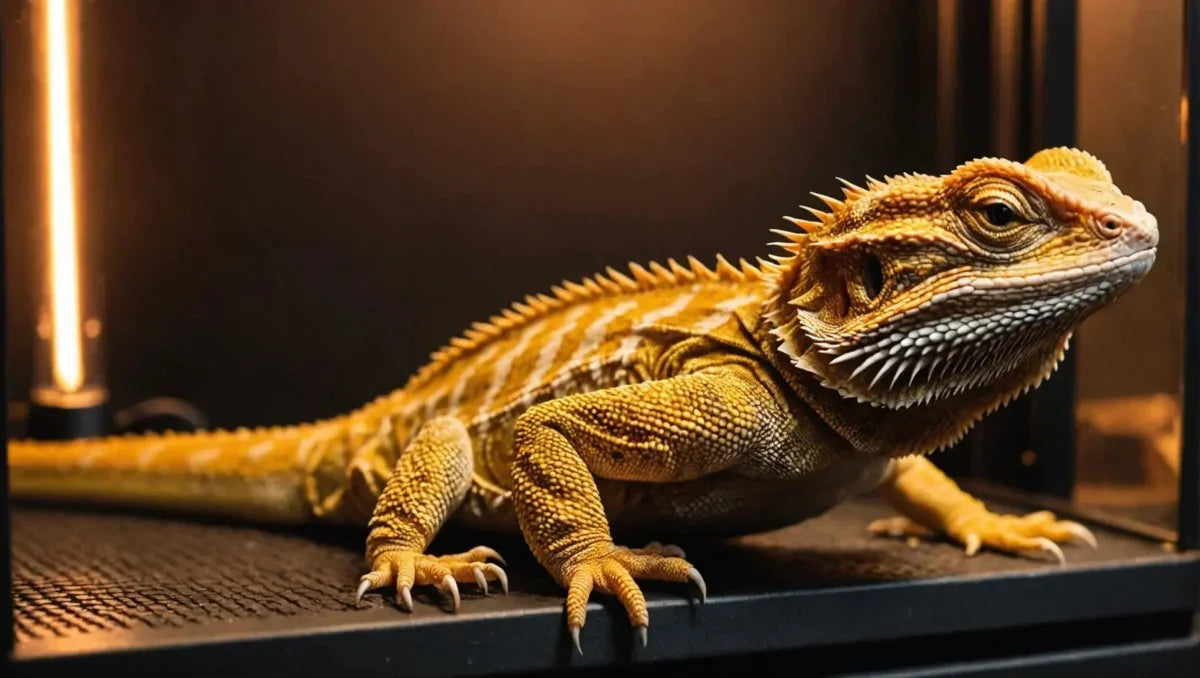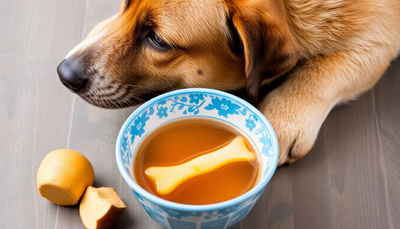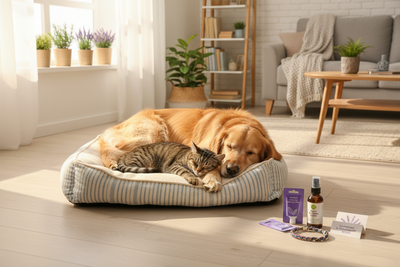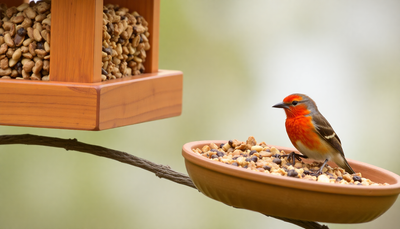Keeping Your Bearded Dragon Warm

Keeping your bearded dragon warm is crucial for its health and well-being. One essential piece of equipment every bearded dragon owner should have is a heat lamp. Bearded dragons, like all reptiles, are cold-blooded animals and rely on external heat sources to regulate their body temperature. A heat lamp provides the necessary warmth for your pet to properly digest its food, stay active, and maintain overall health. Without a heat lamp, your bearded dragon could suffer from health issues such as lethargy, poor appetite, and even serious conditions like metabolic bone disease. In this guide, we will explore the importance of a bearded dragon heat lamp, how to set it up correctly, and crucial tips for creating a comfortable and safe environment for your scaly companion. Understanding the significance of proper heating in your bearded dragon's habitat is the first step towards ensuring a happy and healthy life for your beloved pet.
Understanding Bearded Dragons' Heat Requirements
Exploring the Natural Habitat of Bearded Dragons
Bearded dragons, scientifically known as Pogona, are fascinating reptiles that originate from the arid regions of Australia. Their natural habitat consists of a diverse landscape including deserts, savannas, and woodlands. In these environments, bearded dragons have evolved to thrive under the intense Australian sun, which has shaped their distinct heat requirements.
Temperature Needs of Bearded Dragons
Maintaining the ideal temperature gradient is paramount when caring for bearded dragons in captivity. These cold-blooded creatures rely on external heat sources to regulate their body temperature. During the day, it is crucial to provide a basking spot that reaches temperatures between 95-105°F (35-40°C), replicating the radiant heat they would absorb in their natural habitat. At night, the temperature should slightly drop to approximately 70-75°F (21-24°C) to mimic the cooler evening conditions they would experience.
Importance of UVB Light
In addition to heat, bearded dragons require access to UVB light to support their overall health. UVB light aids in the synthesis of vitamin D3, essential for proper calcium absorption and preventing metabolic bone diseases. It is vital to provide a quality UVB light source in their enclosure to ensure their well-being.
Impact of Incorrect Temperatures
The consequences of incorrect temperatures on bearded dragons can be severe. If the environment is too cold, bearded dragons may struggle to digest their food, exhibit lethargic behavior, and are more susceptible to respiratory infections. Conversely, overheating can lead to heat stress, dehydration, and potentially fatal heatstroke. Maintaining the correct temperature gradient is not just a matter of comfort but a critical aspect of their care.
Monitoring and Adjusting Temperatures
Regular monitoring of temperatures within the enclosure is essential. The use of reliable thermometers and thermostats can help ensure that the basking spot and overall habitat remain within the appropriate range. Adjustments may be necessary based on seasonal changes or individual preferences of the bearded dragon.
Conclusion
Understanding and meeting the heat requirements of bearded dragons are fundamental aspects of responsible reptile ownership. By creating a habitat that mirrors their natural environment, providing adequate heat and UVB light, and vigilantly monitoring temperatures, owners can help their bearded dragons thrive and lead healthy lives.
Bearded Dragon Heat Lamp Features
Types of Heat Lamps Available for Bearded Dragons
When it comes to providing the right heat source for your bearded dragon, selecting the appropriate heat lamp is crucial. There are several types of heat lamps available in the market, each with its own unique features and benefits:.
-
Ceramic Heat Emitters : These heat lamps emit infrared heat without producing light. They are ideal for creating a basking spot without disturbing the bearded dragon's day-night cycle.
-
Mercury Vapor Bulbs : Known for providing both heat and UVB light, mercury vapor bulbs are a popular choice among reptile owners. They help simulate natural sunlight and promote calcium absorption.
-
Infrared Heat Lamps : These lamps emit heat in the form of infrared radiation, which penetrates the skin and helps in maintaining optimal body temperature.
Importance of Selecting the Right Wattage and Type of Heat Lamp
Choosing the correct wattage and type of heat lamp is essential for the well-being of your bearded dragon. Factors to consider include the size of the enclosure, ambient room temperature, and the specific heat requirements of your pet. It's recommended to consult with a reptile specialist to determine the most suitable heat lamp for your setup.
Additional Features to Consider in a Heat Lamp
Apart from providing heat, modern heat lamps come with a range of additional features to enhance functionality and convenience:.
-
Built-in Timers : Some heat lamps are equipped with timers that allow you to set specific on/off cycles. This feature is especially useful for maintaining a consistent day-night cycle for your bearded dragon.
-
Dimmers : Lamps with dimming capabilities enable you to adjust the intensity of the heat output, providing greater control over the temperature gradient in the enclosure.
-
UVB Capabilities : UVB light is essential for bearded dragons' calcium metabolism and overall health. Opt for heat lamps that offer UVB output to ensure your pet receives adequate exposure.
-
Energy Efficiency : Consider energy-efficient models that can help reduce electricity costs while providing optimal heating for your pet.
By carefully evaluating these features and selecting a heat lamp that meets your bearded dragon's specific needs, you can create a comfortable and safe environment for your beloved reptile friend.
Setting Up the Heat Lamp Correctly
One of the most crucial aspects of reptile care is providing the right temperature for your scaly friend. In this guide, we will discuss the essential steps to set up a heat lamp correctly in your reptile's enclosure.
Guide on Where to Place the Heat Lamp in the Enclosure
Proper placement of the heat lamp is vital to ensure that your reptile receives the right amount of heat. Place the heat lamp on one side of the enclosure to create a temperature gradient, allowing your pet to move between warmer and cooler areas as needed. Consider the natural habitat of your reptile species when deciding the placement for optimal comfort and behavioral stimulation.
Tips on Positioning the Heat Lamp at the Correct Distance
To prevent overheating or inadequate heating, it's crucial to position the heat lamp at the correct distance from the basking spot. Follow the manufacturer's guidelines regarding the recommended distance, typically around 12-18 inches, depending on the wattage of the bulb. Monitor the temperature regularly using a thermometer to ensure the basking area remains within the appropriate range for your reptile's species.
Ensuring Proper Ventilation and Safety Measures
While setting up the heat lamp, ensure that there is adequate ventilation in the enclosure to prevent heat buildup and maintain air circulation. Consider adding a small fan to improve airflow if necessary. Additionally, always use a sturdy lamp fixture and secure it properly to prevent accidental falls or contact with your reptile. Regularly check the condition of the lamp and its components to avoid malfunctions that could pose a fire hazard.
Importance of UVB Lighting
In addition to heat, many reptiles require UVB light for proper calcium metabolism and overall health. Consider incorporating a UVB lamp into your setup, following the manufacturer's recommendations for distance and duration of exposure. UVB bulbs degrade over time, so ensure regular replacement as advised to maintain its effectiveness.
By following these comprehensive guidelines, you can create a comfortable and safe basking spot for your reptile, promoting their overall well-being and health while mimicking their natural environment as closely as possible.
Maintaining the Heat Lamp and Monitoring Temperature
Regular Maintenance Tips for the Heat Lamp
Proper maintenance of the heat lamp is crucial to ensure its longevity and effectiveness. Some key tips for maintaining the heat lamp include:.
-
Cleaning: Regularly clean the heat lamp to remove dust and debris that can affect its performance.
-
Inspecting: Check the heat lamp for any signs of wear and tear. Replace any damaged parts promptly.
-
Positioning: Ensure the heat lamp is properly positioned to provide optimal heat distribution.
Importance of Monitoring Temperature Levels
Monitoring temperature levels is essential to create the right environment for your pets or plants. It helps in:.
-
Preventing Overheating: Monitoring temperature prevents the area from getting too hot, which can harm the inhabitants.
-
Avoiding Cold Spots: By monitoring temperature levels, you can identify and rectify cold spots that may be detrimental.
How to Monitor Temperature Effectively
To effectively monitor temperature levels, consider the following:.
-
Use a Thermometer: Invest in a quality thermometer to accurately measure temperature levels.
-
Set Thresholds: Establish temperature thresholds based on the needs of your pets or plants.
-
Regular Checks: Make it a habit to regularly check the temperature to ensure it remains within the desired range.
Additional Tips for Maintaining the Heat Lamp
-
Checking Wiring: Inspect the wiring of the heat lamp for any signs of damage or wear. Faulty wiring can lead to malfunctions or even pose a fire hazard.
-
Replacing Bulbs: Regularly replace bulbs as they age to maintain consistent heat output. Old bulbs may not provide adequate warmth.
-
Cleaning Surrounding Area: Keep the area around the heat lamp clean to prevent dust build-up, which can interfere with heat emission.
Importance of Consistent Monitoring
-
Health Benefits: Proper temperature regulation promotes the health and well-being of your pets or plants, aiding in digestion, metabolism, and overall growth.
-
Behavioral Observations: Changes in temperature can impact the behavior of your pets. Monitoring allows you to adjust the environment accordingly.
Utilizing Technology for Monitoring
-
Smart Thermostats: Consider using smart thermostats that provide real-time temperature readings and alerts for immediate action.
-
Remote Monitoring: Some devices offer remote monitoring capabilities, allowing you to track temperature levels even when you are away.
By incorporating these additional tips and embracing technological advancements in temperature monitoring, you can elevate the care provided through the heat lamp, ensuring a comfortable and safe environment for your pets or plants.
Conclusion
Investing in a quality heat lamp for your bearded dragon is essential in providing the necessary warmth and creating a comfortable environment for your reptile. Proper temperature regulation is critical for their health and well-being, helping to maintain their metabolism, digestion, and overall vitality. By ensuring that your bearded dragon has access to a suitable heat source, you are not only promoting their physical health but also contributing to their overall happiness and longevity. Remember, a well-equipped and well-maintained heat lamp is a key component in the care and keeping of these fascinating creatures.






